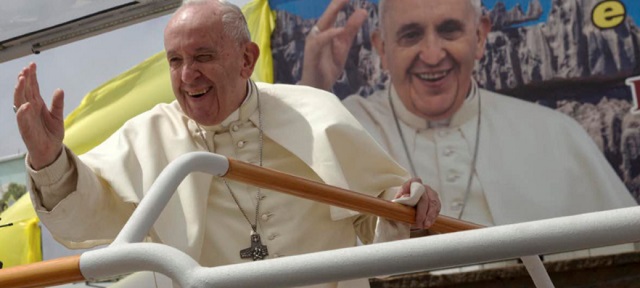
Churches face competition and a troubled legacy as they grow
| JOSEPH HELLWEG | Pope Francis recently completed a seven-day tour of three African countries: Mozambique, Madagascar and Mauritius. It was a significant trip for a number of reasons.
During his visit, the pope spoke on issues of peace and ecological sustainability that these countries are facing. Mozambique recently signed a peace accord with longtime rebels, and the country is still recovering from the cyclone earlier this year that killed over 1,000 people. Madagascar faces severe deforestation, and Mauritius too faces risks from climate change.
Africa has the world’s third largest Catholic population, after the Americas and Europe. Nearly 1 out of every 5 Africans – 19.2% – is Catholic. The Pew Research Center expects the number of African Christians south of the Sahara, including Catholics, to double by 2050.
From my perspective as a scholar of African religions, however, the pope’s visit needs to be understood against the background of the church’s longer history in Africa and the current challenges Catholicism faces in the continent.
Early Catholic history in Africa
Although Catholicism in Africa expanded dramatically under European colonialism in the 19th and 20th centuries, the church’s roots in Africa go back to its earliest days.
Christianity emerged in Africa among first-century Jewish communities in Alexandria, Egypt. Many early, influential church figures were North African.
After the Islamic conquest of North Africa – from 634 to 711 A.D. – however, Islam grew faster than Christianity, making it the region’s dominant religion.
Muslim traders then took Islam across the Sahara Desert to West Africa and over the Indian Ocean to eastern Africa.
Spread of Christianity
The later arrival of Catholic missionaries on the western, central, southern and eastern coasts of Africa spread Christianity across the continent.
In the 15th and 16th centuries, the Portuguese came to Africa by ship and began winning converts in the Central African kingdom of Kongo.
On the other side of the continent, in today’s Mozambique, missionaries established Catholic communities that would eventually become the contemporary Mozambican Church.
French missionaries arrived in Madagascar in 1640. With the help of early converts, they produced a Catholic catechism, or teaching manual, in Malagash, the island’s indigenous language.
Because Catholic Portugal, and later France, expanded the trans-Atlantic slave trade, both priests and slave merchants followed in their wake.
African Catholics and European missionaries nonetheless protested against the slave trade. Even the Vatican condemned slavery in the 1680s. But many bishops and priests already possessed slaves, and the Vatican enslaved Africans to man its ships.
The church’s complicity in Africa’s subjugation only intensified in the colonial era in the 19th and 20th centuries as the church founded parishes, schools and hospitals across the continent, often with the encouragement of colonial authorities.
 The Independent Uganda: You get the Truth we Pay the Price
The Independent Uganda: You get the Truth we Pay the Price



